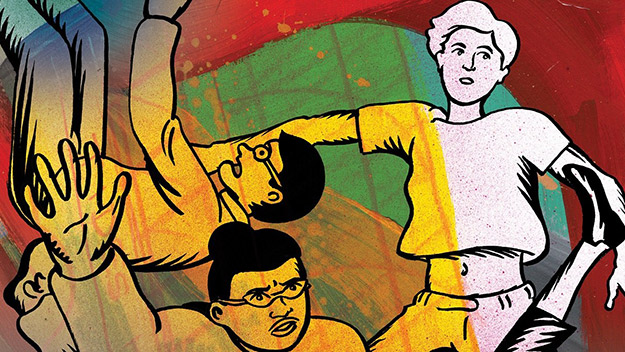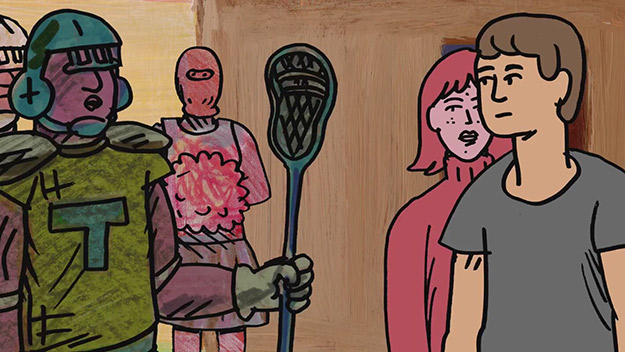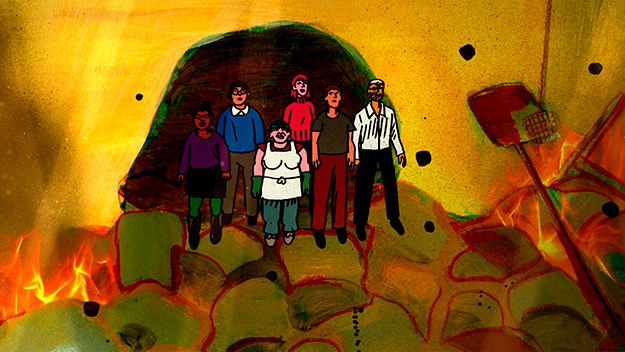Dash Shaw’s brief, cheeky animated feature, My Entire High School Sinking into the Sea, is in some ways what it sounds like: The Breakfast Club meets The Poseidon Adventure. But it isn’t lachrymose or message-laden like The Breakfast Club and it embraces and lampoons the excessive silliness of disaster movies. In this film, most of the In Crowd fails to act nobly or achieve redemption. Even a mean girl who teeters on the brink of amiability gets chomped to death by lots of little sharks. In other words, she proves to be popular yet again, this time with man-eating fish. In this blessedly irreverent action farce, conformity isn’t merely dull and oppressive—it’s lethal, or maybe suicidal. And high school isn’t merely a place—it’s a brain-fogging state of mind. What’s hilarious is that, in the midst of carnage, a bookish girl complains, in her usual monotone, that she hates going to a party because she can’t really talk to anyone there. After a wave of Young Adult films that wear their vulnerability and sensitivity on their sleeves or, worse, their doomed heroines’ oxygen tanks (I’m looking at you, The Fault Is in Our Stars and If I Stay), My Entire High School Sinking into the Sea operates on regular moviegoers like spinach does on Popeye: its witty heartlessness activates a muscular sense of irony. What a relief it is to watch an unsentimental teen movie! It’s also mercilessly autobiographical: the hero/protagonist/lead jerk is named Dash, and he’s given voice by Jason Schwartzman, an actor who never shies from embodying cringe-worthy qualities. We meet Dash and his best bud Assaf (Reggie Watts), the star reporters—indeed, the only reporters—on the Tides High School newspaper, as they bus in to their first day as sophomores. Freshmen ignore them; upperclassmen disdain them. Sophomores are the middle children of high school, and Dash and Assaf are sophomoric to the max.
Personally, their peak achievements have been eliminating zits (Dash) and shedding most of a “spaghetti belly” (Assaf). Professionally, they once achieved notoriety with a fabricated story about a haunted locker. Now they hype school news with Dash’s purple prose. As freshmen, they worked as a team. As sophomores, their editor, a lonely, earnest female friend named Verti (Maya Rudolph), separates their assignments to get twice the number of articles. She figures, correctly, that once she divides these bosom buddies, Assaf will generate some accurate reporting. She also assigns Assaf a restaurant review so they can go to a sushi joint together. Fearing that everything is slipping away from him, Dash lashes out at the new couple in his own special edition of The Tides Gazette: he writes a blistering expose of Assaf’s erectile dysfunction (a total invention). He pipes a quote from that doomed mean girl: “‘Chubby’ can’t get a chubby.” What’s most original and truthful about the movie is Dash’s adolescent ruthlessness. Few cartoon characters have been more aptly named: Dash acts on his feelings of betrayal immediately, decisively, and stupidly. And he doesn’t pause to make amends, which feels truer than blubbery scenes of remorse. When Dash does reminisce about his and Assaf’s shining buddyhood, it’s with a delightful oddball flashback to a Boy Scout camping trip involving clean socks and dirty underwear. This brisk 72-minute film has no time for sappiness, anyway. During the team’s initial breakup, Assaf was supposed to be reporting on construction of the school’s new rooftop auditorium. So it’s a delicious irony that when Dash is sent to the basement detention room, he finds building papers that prove the school will not survive a tiny earthquake. Before long, a Level Two quake sends Tides High School tumbling into the Pacific. Along with pert gymnast and sophomore cool girl Mary (Lena Dunham), who is smart enough to recognize when Dash knows what he’s doing, the reunited pals and Verti maneuver among floods, flames, and, yes, man-eating fish as they strive to journey four floors up to salvation. (In the film’s cleverest design stroke, each class occupies a single floor, in ascending order—freshmen on the bottom, seniors on top.) Along the way they pick up the cafeteria slop-master, Lunch Room Lorraine (Susan Sarandon), who is part martial artist, part Iron Chef, and Drake (Alex Karpovsky), a pothead musician who whines that he was meant to be home-schooled.
The voice actors resonate with deadpan personality. In addition to Schwartzman as Dash, a virtuoso of misplaced vehemence, Dunham, as Mary, proves to be unexpectedly uproarious at projecting a limber kind of confidence, while Rudolph, as Verti, is just as funny at mastering an extreme passive aggression. And Sarandon masters a gruff comedic style as Lunch Room Lorraine, who spouts impressive but opaque warrior wisdom. It’s crucial that they come through as strongly as they do, because Shaw shoots the moon as an animator. Best known until now as a graphic novelist, he puts together a hand-made phantasmagoria out of drawings, cut-paper backgrounds and profiles, as well as actual flames, water, and light shows. He uses a computer program for choreographing images rather than creating them, and he conjures an extravagant visual comedy from his ability to keep us in a pleasant sort of shock. In its nonstop invention and merger of cartoon and comic book styles with modern and Pop Art collage, My Entire High School Sinking into the Sea is like a low-budget Yellow Submarine—especially, of course, when the school goes underwater. The human figures are alternately stiff and wavering, and at times both, simultaneously: some of their hairlines change position, even from frame to frame. Shaw has acknowledged the influence of manga, anime, and Saturday-morning TV cartoons from the ’70s, ’80s, and ’90s, but he surrounds his creations with a semi-satiric aura that recalls “Robert Smigel’s TV Funhouse” from Saturday Night Live. Shaw positions his unlikely action figures in a powerhouse potpourri that includes split screens, noirish shadows, electric skeletal images from better high school educational films, Pop impressionism, and psychedelia. Images of lungs breathing heroically or fighting for air, and of a cotton swab invading an ear canal, boast the colorful creepiness of the old Visible Man modeling kits. What’s fun about My Entire High School Sinking into the Sea can’t be separated from its swiftness and casualness: it never asks you to take it all that seriously. But it’s got a fluky sensibility all its own. Merging his memories of middle school and high school with visions constructed from the cartoon warehouse in his brain, Shaw has created something pleasurable and unique: a piece of Pop outsider art. Michael Sragow is a contributing editor to Film Comment and writes its Deep Focus column. He is a member of the National Society of Film Critics and the Los Angeles Film Critics Association. He also curates “The Moviegoer” at the Library of America website.


